Rising Generation Aiding Remarkable Growth of Church in Cambodia
Contributed By Aubrey Eyre, Church News staff writer
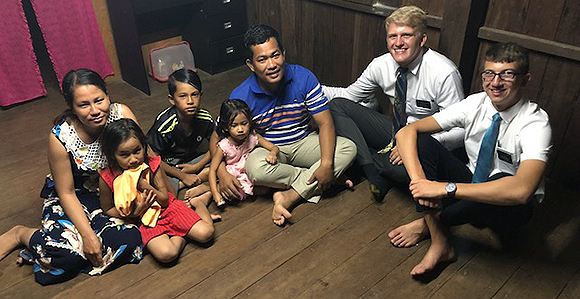
Elder Bailey (right) and Elder Christiansen meet with a family at their small shop. Photo courtesy of John Lewis.
Related Links
When it comes to loving and serving his neighbors, Keom Chhoeun Hul doesn’t hesitate. As the elders quorum president in his local branch, Hul has taken it upon himself to see that one of the most common challenges facing Church members is overcome with relative ease, every Sunday morning.
In the rural and green landscape of Cambodia’s Kampong Thom province, getting to the meetinghouse for Church isn’t an easy task—especially for members who live far from the building or have limited to no means of transportation.
So, rising with the sun, Hul spends his Sunday mornings before Church driving his Tuk Tuk—a Cambodian motorcycle with an attached carriage—and pulling an extra trailer. Hul goes from house to house, picking up members of his congregation and taking them to the meetinghouse in time for their 8 a.m. sacrament meeting. Nearly 20 members and families are blessed by his service each week.
“He’s very dedicated in helping people get to church,” said President John Lewis, president of the Cambodia Phnom Penh Mission.
One of the biggest reasons Church members in Cambodia become inactive after baptism is due to the difficulty and cost of getting to church. Issues of transportation are a common factor, President Lewis said, but as the country slowly improves its infrastructure and as members learn to serve one another, the Church will only continue to grow.
He added, “It’s amazing to see what people can load on a Tuk Tuk.”

Missionaries with a Church leader from Kampong Thom who uses his Tuk Tuk every Sunday to pick up members who live far from the Church building to get them to the church for services. Photo courtesy of John Lewis.
Challenges of faith
Cambodia’s climate, like that of the rest of Southeast Asia, is dominated by monsoons. The rainy season is generally accompanied by high humidity. During the dry season, temperatures can reach up to 104 degrees Fahrenheit.
Theary Leng, a native Cambodian from the Kampong Cham province, remembers the difficulty of getting to church when she was younger. Unable to afford a motorbike or a car, her family would bike to church every Sunday, despite the weather.
“It took us like 30 or 40 minutes,” Leng said. “Sometimes it was raining and sometimes it was really hot.”
Leng said she remembers often questioning to herself why they went through the trouble.
Noting that there are many families who don’t even have bikes, Leng described how some people take taxi-like Tuk Tuks to church, which means not only are they not working and earning money, but they have to spend money to get to church. It is a great sacrifice for them, Leng said.
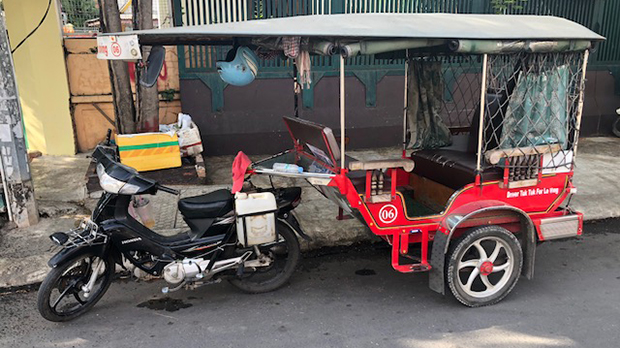
A typical Tuk Tuk parked near the mission home in Phnom Penh. Cambodians often use these modified motos to transport goods and people around the cities and countryside. Photo courtesy of John Lewis.

Graphic by Aaron Thorup.
“But everything has to come on your own,” she said. “Once you understand [the gospel] and you know it, when you have a true conversion, most likely you will stay strong in the Church.”
And for the rising generation of Church members in Cambodia, making the sacrifices necessary for true conversion is all part of their learning curve.
A learning process
Hul is an example of how Church members in Cambodia are beginning to own the idea of ministering to one another, President Lewis said. It was only 24 years ago that The Church of Jesus Christ of Latter-day Saints was officially established and recognized by the government of Cambodia, so the Church is still considered very young there.
“[The members] have hearts of gold in wanting to care for each other, but they’re young in the Church so they’re still learning how to do their duties, … how to support one another,” President Lewis said.
Despite its youth, the Church has grown remarkably fast, and it doesn’t seem likely to slow down anytime soon.
The first convert in Cambodia was baptized in May 1994. Now, in 2018, Church membership in the country stands at 14,256 and is steadily growing. In 2014, the first two stakes were established in the country, and, President Lewis said, it won’t be long before there is a third.
“The growth continues and the strength of the membership continues,” President Lewis said. “It’s quite an exciting place to be.”
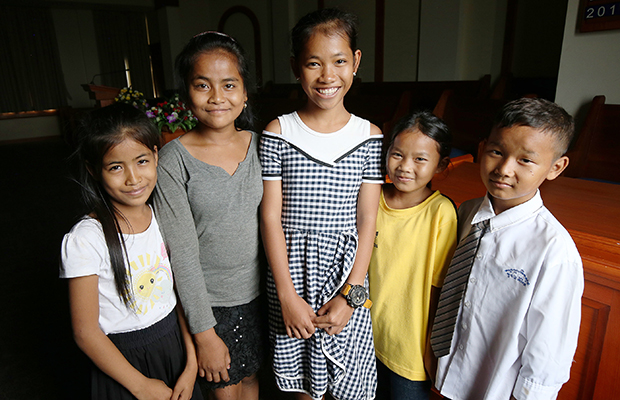
Kampong Thom Branch Primary children pose in the chapel in Cambodia on April 28, 2018. Photo by Jeffrey D. Allred, Deseret News.
Centered on family
The first time Elder Michael and Sister Janis Smith, public affairs missionaries for the Church in Cambodia and Thailand, traveled to that corner of Southeast Asia, they said they were impressed by two things.
First was the beauty of the countryside.
“I wish I could describe the color of the rice fields and the palm oil palms and the banana palms that separate the farmers’ land out there,” Elder Smith said. “Every time I drive out there I try to fill my eyes. Photos are nice, but they don’t reflect the beauty and the pastoral peace that you feel out there.”
But while the landscape is rugged and breathtaking, he said, there is also immense poverty among those whose entire livelihoods depend on the work of the rice paddy fields.
Second, they were impressed by the family-centric nature of Cambodian society.
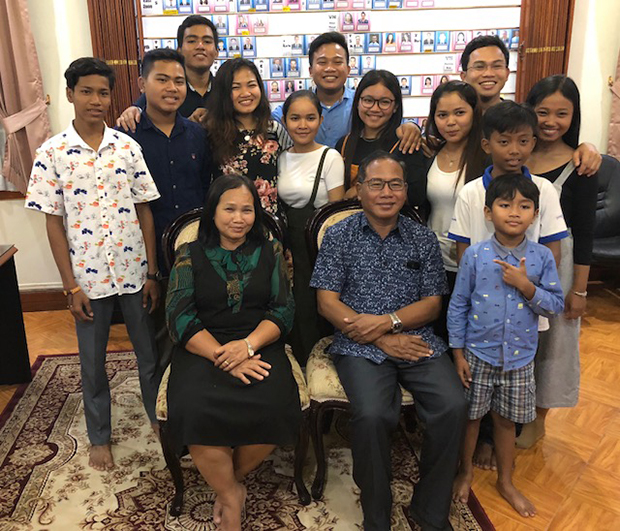
A family from Battambang meets at the mission home to celebrate the release of Sister Sorn from Tacoma, Washington. The family represents three generations of Church membership, with the first having joined nearly 17 years ago. Photo courtesy of John Lewis.
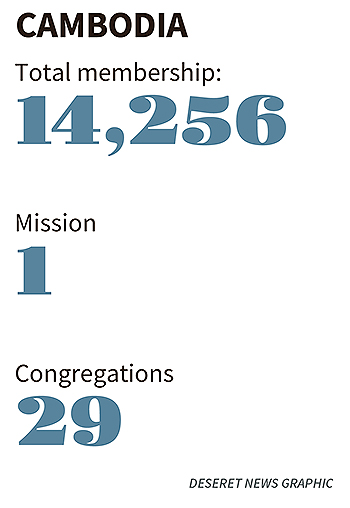
Graphic by Aaron Thorup.
“The men are nurturing just as much as the mothers are,” Sister Smith said. “They just love their little kids.”
“All the culture is centered on the family,” Leng agreed. “We really praise the family, and we think that bond is really important.”
As many families now begin to reach their third generation of membership in the Church, their dedication to the gospel principles is growing with their knowledge of the eternal importance of families.
President Lewis noted that many families are making it a priority to hold current temple recommends, and the number of couples and families making trips to the temple to be sealed is increasing steadily as well.

Missionaries and members outside their chapel in Kampong Cham, Cambodia. Photo courtesy of John Lewis.
Working against the odds
With the majority of its population working as farmers, merchants, and laborers, Cambodia has worked to improve its economy and move into the modernized world.
And although many lives are still focused on finding where their next meal will come from, President Lewis said, “The entrepreneurial spirit of life is very much alive.”
Leng’s parents grew up during the genocide, when the Khmer Rouge were in power, and as she described, both her mother and father received little more than the education required to teach them the basics of reading and writing. With no more than three or four years of education each, Leng said her parents experienced the true hardships of war but have always been able to find a way to provide.
Currently, Leng’s father, Leng Hun, works as a security guard for the Church. “He also makes and sells soy milk,” Leng said, explaining that her father has found various means over the years of generating extra income as needed.
“The average income he makes is about $10 a day,” Leng said. “It’s pretty good income for over there, but not really good.”

Kampong Thom Branch member Somnang Pat holds her baby, Dana, after church in Cambodia on April 28, 2018. Photo by Jeffrey D. Allred, Deseret News.
The average daily wage is around $3–$4 for many, and as a result people will often prioritize work and money over education to meet their basic needs.
Reflecting on where she grew up, Leng said most of her neighbors didn’t seem to value education.
“I’m grateful that my parents, especially my dad, understands the value of education,” Leng said.
Although she and her older brother were both able to graduate high school, Leng said she remembers her father worrying often that he wouldn’t be able to support her finishing. But she was a dedicated student who worked hard, and her parents did all they could to help her reach her goal of graduating.
Following high school, Leng set her sights on the idea of college. She applied for loans through the Church’s Perpetual Education Fund as well as scholarships.
After landing a full scholarship to a local college in her province, Leng said she felt lucky to have had all four years of college paid for. And she said she feels even more blessed for her current schooling opportunities. She is currently studying for a masters of public administration at Brigham Young University.
Recognizing the importance of education for her country, Leng said she intends to return to Cambodia and work with NGOs and nonprofit organizations to help provide more opportunities for young people to receive education there.

A typical Cambodian entrepreneur on the side of the road selling goods. Photo courtesy of John Lewis.
The Church is maturing
Sophornn C. Touch was first introduced to the Church in Cambodia in 1994 when he began attending English classes taught by the missionaries.
“My motive was not to learn the gospel, but to learn English,” he said.
However, in the process he discovered something he could not deny. He was baptized March 22, 1998. A year later he received a called to serve in the California Sacramento Mission.
“When I went to my mission, I had been thinking about my future,” Touch said. “I kept thinking about ‘what I am going to do?’ I had no education. The jobs in Cambodia were meager and payment was not that much.”
He consulted his mission president, who suggested he enroll in BYU–Hawaii. After graduating from BYU–Hawaii, Touch received a graduate degree from the University of Hawaii and found work with the Church.
Then one day while reading his patriarchal blessing, Touch knew he needed to return to Cambodia. Now married to Ludy Ann Campo Touch, the couple decided to take their family home to Cambodia.
He said the gospel and membership are maturing in his country. Cambodian members “have strong faith in the Lord Jesus Christ,” he said.

Elders Christensen (left) and Bailey meet with a recent convert shortly following his baptism. Photo courtesy of John Lewis.
Elevating the Church
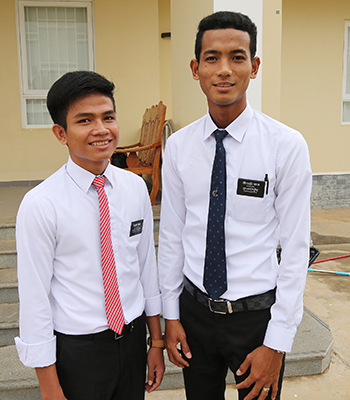
Elders Oudomvichea Yous and Karona Phork pose after attending the Kampong Thom Branch in Cambodia on April 28, 2018. Photo by Jeffrey D. Allred, Deseret News.
With nearly 97 percent of Cambodia’s population identifying as Buddhist, the culture of the country is steeped in Buddhist history and traditions.
“Because Buddhism is rooted deeply into the cultures and traditions, usually if you convert to Christianity it can be weird because some people may say you abandoned your own culture,” Leng said.
The Christian population is only 0.4 percent in Cambodia, and as such, it would be easy to assume that members of the Church might be seen as outsiders. But as Elder and Sister Smith explained, the Church holds a very positive standing among the people and government entities within Cambodia. It may even be the most prominent Christian religion there, they said.
Elder Smith described a recent instance where a Christian family from Thailand took a trip to Cambodia. After arriving, they hailed a cab and asked the driver if there was a Christian church anywhere nearby. Not a Christian himself, the cab driver took the family to the only Christian church he knew of.
“[The Church] is so prominent here, … he brought them to our building,” Elder Smith said. “They were not [members], but it was the most prominent Christian building in the city. So we have a really good reputation.”
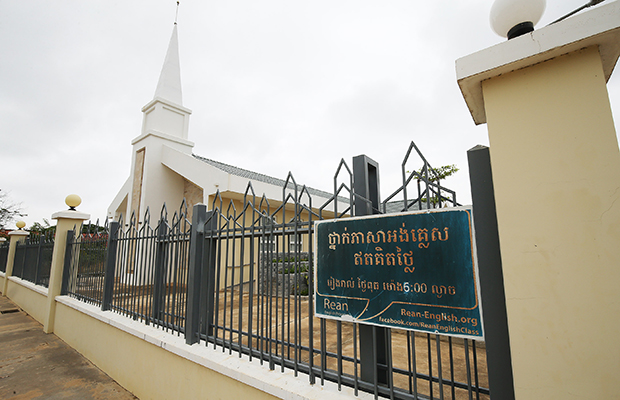
Kampong Thom Branch in Cambodia on April 28, 2018. Photo by Jeffrey D. Allred, Deseret News.
And despite the cultural differences of Buddhism and Christianity, President Lewis said that those who meet with the missionaries can usually accept the gospel message rather quickly. Pointing to the gospel’s focus on forgiveness, which in Buddhism it is believed a person cannot attain until the next life, President Lewis said, “So when a missionary teaches that we have a loving Heavenly Father that sent His Son to be our Savior and Redeemer, it immediately gives tremendous hope because it means they can be forgiven in this life. And that message resonates.”
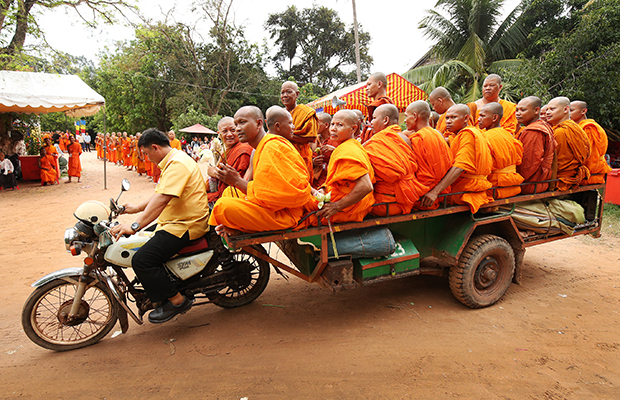
Buddhist monks ride during a religious ceremony at Angkor Wat in Cambodia on April 28, 2018. Angkor Wat is a 12th-century temple complex in Cambodia and the largest religious monument in the world. Photo by Jeffrey D. Allred, Deseret News.
A bright future
Another aspect that sustains the Church’s good standing is their many humanitarian efforts in the country. In addition to helping build wells for clean water, providing health and immunization care, and food and housing projects, the Church’s humanitarian efforts often help out during times of disaster.
August this year brought major flooding to the Kampong Cham province. With hundreds of rice paddy fields flooded and ruined before harvest, the Church and LDS Charities responded to the needs of some of the devastated communities.
On a bright morning in late September, representatives from the Church, including President Lewis, arrived in the rural community of Maha Leap, where nearly 600 representatives of families from flooded areas sat next to rows of food donations from the Church.
President Lewis said, “It was an emotional scene of ‘feeding the poor and needy’ whose homes had been flooded and crops washed away.”

Residents of the rural community of Maha Leap wait for the arrival of the governor with the donations they received from LDS Charities. Photo courtesy of John Lewis.
Each representative was given bags of rice, cans of fish, and boxes of noodles and soy sauce to help supply their families as they recover from the flood damages.
While members in Cambodia continue to face the challenges of their developing country, both Leng and President Lewis said their hope for the future of the Church there is bright and unwavering.
“The development of the Church here is certainly in front of us,” President Lewis said.
Their optimism for the growth of the Church was strengthened earlier this year when Elder David A. Bednar of the Quorum of the Twelve Apostles visited Cambodia and referred to it as a “new Kirtland” based on the strength of its members. (See related story.)
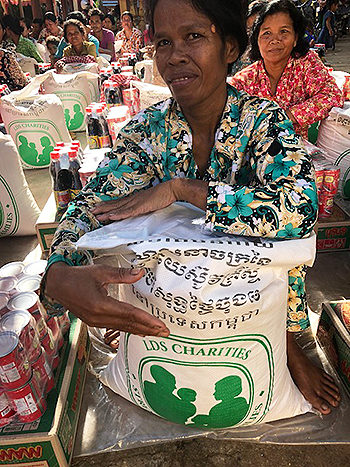
Residents in Maha Leap receive LDS Charities donation bags of rice with cans of fish, boxes of noodles, and soy sauce in late September following flooding in their rural community. Photo courtesy of John Lewis.
“We have a bright future,” said Touch. “We are on a bright path.”
“Faith is a principle of action and power,” Leng said, noting that the Cambodian people have great faith. “The only way you can overcome struggles and poverty is through faith in Christ.”
Leng said one of the lessons she has learned is that obedience and conversion to Christ is a lifelong process. “It took a long time for me to see that,” she said. “It’s not just a short period and then you can expect to see blessings afterward. … You can’t expect blessings without any work.”
So while the Church membership is still young, she said, Cambodia’s strength in the gospel is continually growing, just like her own.
“Because I am converted and I know it is true, it doesn’t matter what happens now,” Leng said. “I know it’s going to be OK in the end. Maybe right now it’s hard, but once we follow all the teachings, we will be OK at the end.”

Volunteers from the Church distributed LDS Charities donation bags of rice with cans of fish, boxes of noodles, and soy sauce to residents in Maha Leap in late September following flooding in their rural community. Photo courtesy of John Lewis.
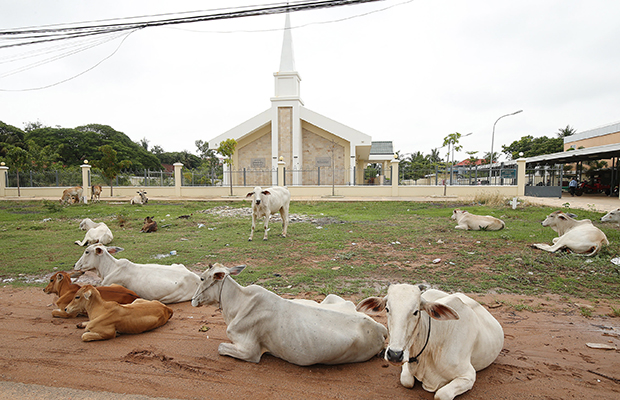
Cows rest near the Kampong Thom Branch in Cambodia on April 28, 2018. Photo by Jeffrey D. Allred, Deseret News.
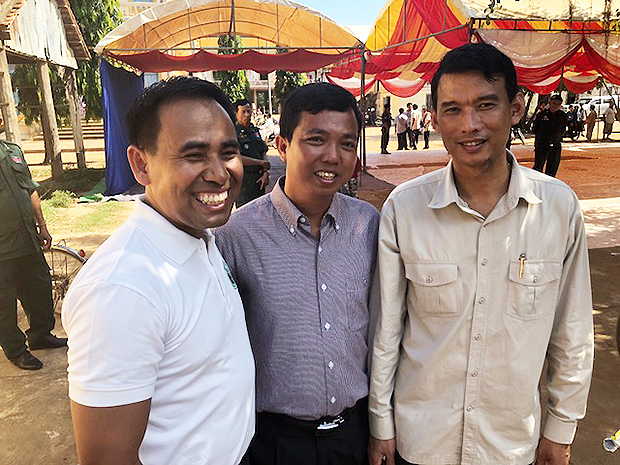
Samnang Sea (left) stands with two of the government officials with whom he worked closely to coordinate the efforts of the Church and LDS Charities for the distribution of food—the director of Cults and Religion for the Kampong Cham province and the district governor. Photo courtesy of John Lewis.
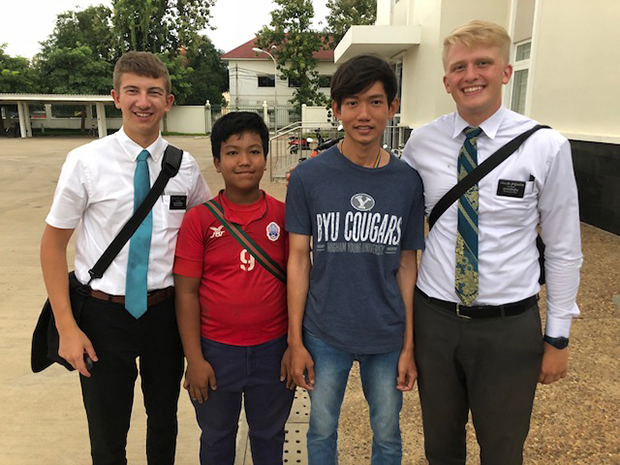
Elders Bailey (left) and Christiansen meet with Dara Leng (third from left) as he prepares to leave on a mission.
Photo courtesy of John Lewis.

Missionaries meet with a Church member in Mongolia. Photo courtesy of John Lewis.

Buddhist monks wave during a religious ceremony at Angkor Wat in Cambodia on April 28, 2018. Angkor Wat is a 12th-century temple complex in Cambodia and the largest religious monument in the world. Photo by Jeffrey D. Allred, Deseret News.

Visitors to Angkor Wat walk near the Siem Reap River in Cambodia on April 28, 2018. Angkor Wat is a 12th-century temple complex in Cambodia and the largest religious monument in the world. Photo by Jeffrey D. Allred, Deseret News.

Children play near a display at Angkor Wat in Cambodia on April 28, 2018. Angkor Wat is a 12th-century temple complex in Cambodia and the largest religious monument in the world. Photo by Jeffrey D. Allred, Deseret News.

A sculptor works on a statue in Cambodia on April 28, 2018. Photo by Jeffrey D. Allred, Deseret News.

A man fishes in Cambodia on April 28, 2018. Photo by Jeffrey D. Allred, Deseret News.

Street markets near the mission home in Phnom Penh, Cambodia. Photo courtesy of John Lewis.
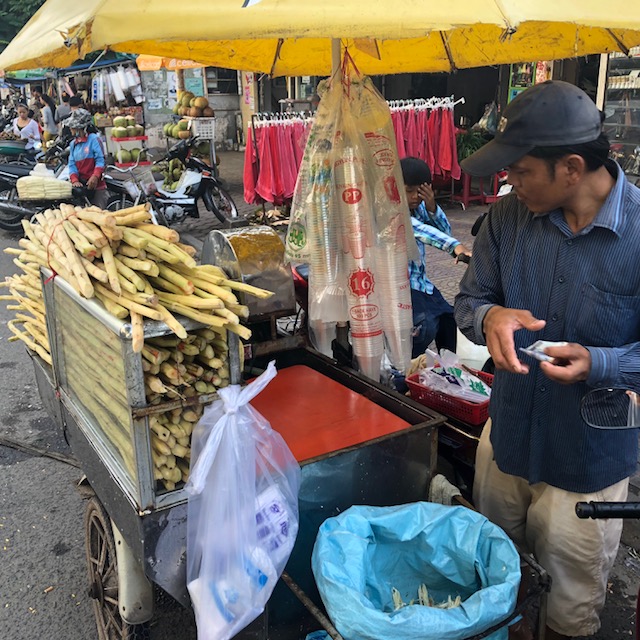
Street markets near the mission home in Phnom Penh, Cambodia. Photo courtesy of John Lewis.
